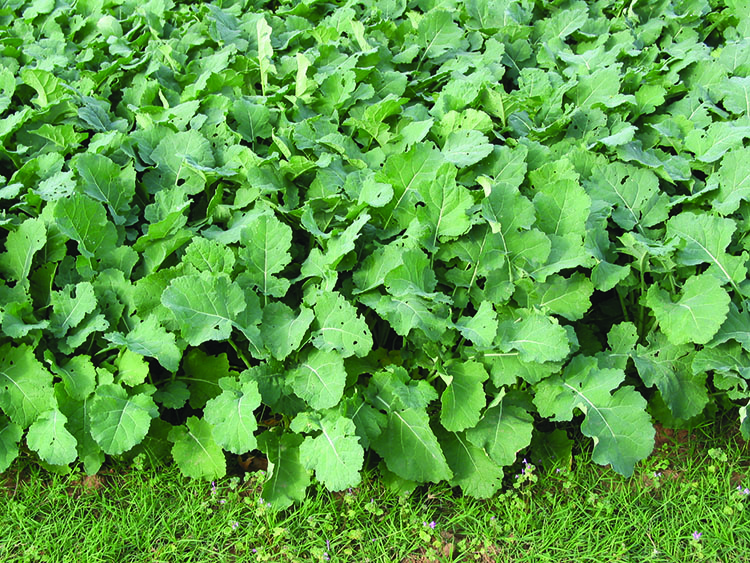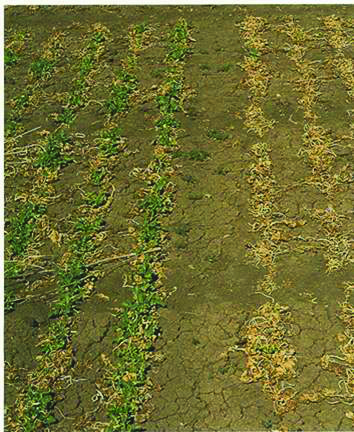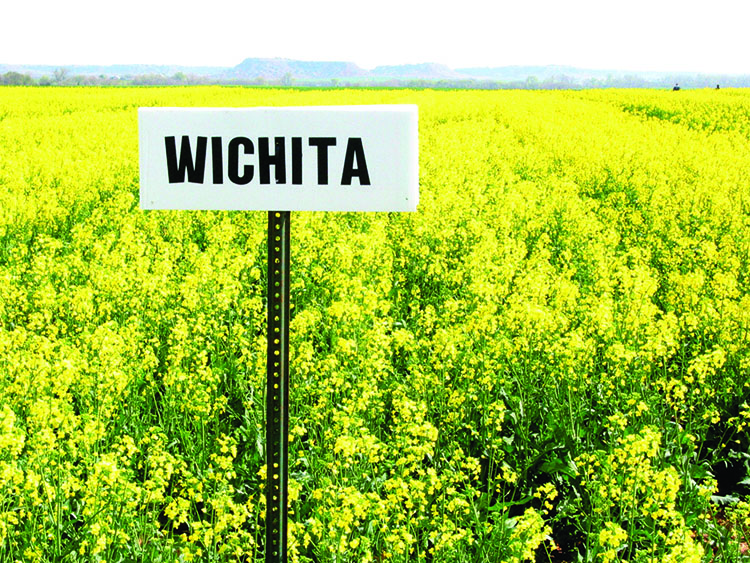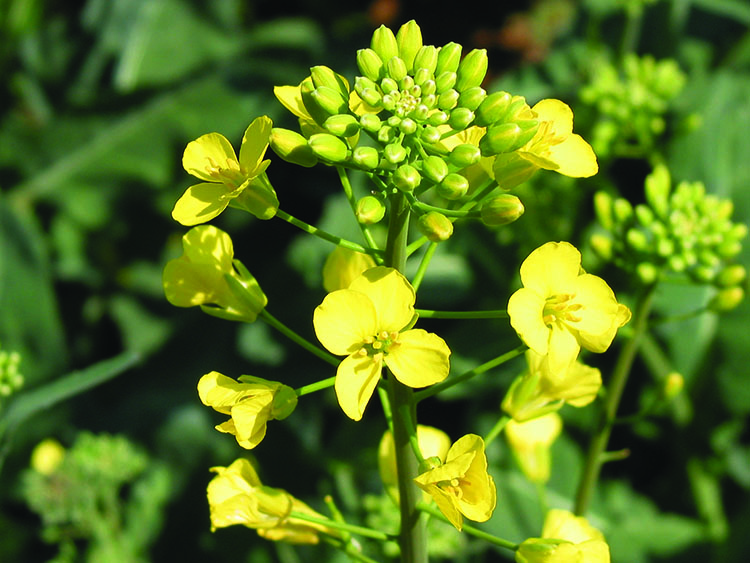Managing Winter Canola in Oklahoma
Canola (Brassica napus) is a broadleaf crop primarily grown for its edible oil and meal qualities (Figure 1). The term canola was trademarked by the Western Canadian Oilseed Crushers Association in 1978. Canola was derived from a rapeseed plant using traditional plant breeding methods to lower the content of erucic acid in the seed oil and glucosinolates in the meal. These changes improved canola’s usefulness as healthy cooking oil for humans and protein supplement for livestock feed. Canola seeds have approximately 40 percent oil and contains two poly-unsaturated fatty acids that are essential in our diets and help prevent heart disease and arthritis. Canola oil contains 6 percent saturated fat, the lowest level of any commercially available vegetable oil. Canola meal (Figure 2) is sold as mash or pellets and contains approximately 34 percent protein. The U.S. imports the equivalent of 2 million acres of production each year, so a domestic market for the oil and meal already exists.
In the early 2000s, cooperative research efforts funded by federal and state agencies have developed winter-tolerant varieties. These new winter-tolerant varieties offer promise as a rotational crop with winter wheat. The varieties Wichita, Abilene and Sumner were released in 1997, 2002 and 2003, respectively. All of these are conventional canola varieties. Sumner also is sulfonylurea-residual tolerant, allowing more flexibility in a winter wheat rotation. Shortly thereafter, glyphosate-tolerant canola varieties were released, allowing for the application of glyphosate over the top during vegetative production stages. In recent years, increased input from private and public breeding programs have provided the industry with a large amount of genetic material to fit into many production systems.
Growing winter canola is much like growing winter wheat. Winter canola and winter wheat are planted and harvested about the same time, with winter canola planting being slightly more restrictive than winter wheat. Canola can be produced with small grains, as well as traditional row-crop equipment, limiting the need for additional machinery. Production costs of canola are similar to those for winter wheat. Canola yields a little less than wheat and has a lower test weight (e.g. 50 pounds per bushel), but typically will have a higher market price. The low investment costs and increasing consumer demand for canola oil makes it a potentially good alternative rotational crop for Oklahoma wheat growers.

Figure 1A. Winter Canola.

Figure 1B. Winter Canola.

Figure 2. Canola meal in pellets.
Potential Benefits of Growing Winter Canola in Oklahoma
- A winter wheat-canola rotation can increase the viability of wheat production systems within the state.
- Management of mixed infestations of problem weeds in wheat, such as cheat, ryegrass, jointed goatgrass, rescuegrass, wild oats and feral rye will be easier in canola, since many herbicides, such as Assure II, Poast Plus, Select or glyphosate (only for use in Roundup® Ready canola) are labeled for use on canola and will control all of these weeds.
- Rotating winter canola with winter wheat should improve the marketability of the wheat because of improved consistency and quality and lower dockage after a canola rotation.
- Canola production would give wheat growers the opportunity to produce a commodity that is tied to a market other than the grain market. Canola is tied closer to the oilseed market. This gives farmers the opportunity to diversify economic risks.
- Including canola into the cropping rotation can break wheat disease and insect cycles decreasing these problems in the following wheat crop.
- Crop rotations have long been considered important for sustainable crop production. Research by Dr. Gene Krenzer showed a four-year average wheat yield increase of 7.8 bushels per acre when wheat was rotated with winter canola.
Crop rotation has the potential to be a major part of the long-term weed management strategy, essential for Oklahoma to be a reliable supplier of high quality wheat.
Site Location for Planting Winter Canola
Canola grows best in medium-textured, well-drained soils, but it will grow with wide range of soil textures. Generally, soils that can produce wheat should be able to produce canola. Canola is slightly more sensitive to soil pH compared to winter wheat. Optimum pH conditions range from 6.0 to 7.0 and significant yield losses can be seen below 5.7 (compared to 5.5 with wheat). Canola does not tolerate water-logged conditions and should not be grown in fields prone to standing water, flooding or poor drainage.
Germinating canola seedlings are very susceptible to many herbicides commonly used in other crops grown in Oklahoma. Rotation restrictions of these products are found on the product label and should be followed. Table 1 lists common herbicides used in wheat, corn, sorghum and soybean crops, and the waiting period between application and seeding canola.
Table 1. Common herbicides and the waiting period before seeding canola.
| Herbicide | Waiting period before seeding |
|---|---|
| Affinity BroadSpec | 60 days |
| Ally | 10 months if pH < 6.5 18 months if pH > 6.5 |
| Axial XL | 90 days |
| Glean | 18 months |
| Finesse | Label not specific (14 to 18 months) |
| Amber | No sooner than 4 months - do a bioassay |
| PowerFlex | 9 months |
| Maverick | Not listed (10 to 14 months) |
| Harmony Extra | 60 days |
| Express | 60 days |
| Olympus | Field bioassay |
| Osprey | 10 months |
| Atrazine | Second fall following application |
| Dual/Frontier | 18 months |
| Beyond/Raptor | 18 months |
Variety Selection
The most important factors in considering a variety for the Great Plains are quick emergence, good fall growth and winter survival. Figure 3 show the differences between good and poor winter hardiness. Unless a variety is proven to withstand winter conditions in your area, do not plant. Other characteristics that need to be considered when selecting a variety include seed yield, seed oil content, oil quality, herbicide residual tolerance, herbicide resistance, acid soil tolerance, lodging, shattering, maturity and disease resistance.
Commercially available cultivars are either open-pollinated varieties or hybrids. Hybrid seed size is usually 30 percent to 40 percent larger than open-pollinated variety seeds. Larger seed size can make seeding easier, but does not always translate into increased yield. The seed cost of hybrid canola is greater than open-pollinated canola because of the cost associated with producing the seed. While yield potential can be increased with use of hybrid canola, most current commercially available cultivars are often open-pollinated because of their increased stress tolerance and winter hardiness.
In addition to commercially available cultivars being either open-pollinated or hybrids, they can also be either conventional or herbicide resistant. Herbicide-resistant cultivars include Roundup Ready® and Clearfield® cultivars. Meaning these cultivars can be sprayed with post-emergent herbicides to control a broad spectrum of weeds before canola bolts. Regardless of canola cultivars being either conventional or herbicide resistant, they both can have residual herbicide tolerance traits. Cultivars with residual herbicide tolerance traits can tolerate herbicide residues still active in the soil from herbicide applications made to preceding crops. Sulfonylurea Herbicide Tolerance (SURT) is the most common of these traits. Canola cultivars with this trait can tolerate Sulfonylurea herbicides (such as Finesse®, Maverick®, Glenn®, Amber® and Ally®) applied to the previous wheat crop without damage to the canola crop.
The Wichita cultivar (Figure 4) was released in 1999 as the first winter-hardy canola variety in the Great Plains. With more interest in winter canola production in the region, the number of commercial cultivars has increased significantly. More than 22 commercial cultivars are now available. Seed companies and local university breeding programs are investing more resources to provide technological advancements in new cultivars on a frequent basis. Check with local Extension offices for current regional variety testing results. It is wise to review trial results from multiple years because certain varieties will perform better with different growing conditions. Also check with local seed dealers for cultivar seed availability and performance data.

Figure 3. Differences in winter survival between varieties can be dramatic. A winter-hardy variety is on the left, while a variety prone to freezing out is planted on the right.

Figure 4. Wichita, a canola variety released by Kansas State University in 1999, is well suited for Oklahoma.
Canola Growth and Development
A number of differences exist for the growth and development of winter wheat and canola. Understanding these differences will allow growers to make more effective management decisions. One of the primary differences is the location of the growing point. Unlike wheat where the growth point is located below ground, canola’s growth point is above ground and exposed as soon as the plant emerges. This is critical for canola production. Having the growth point exposed makes the canola plant more susceptible to mechanical or physical damage during early growth and development, including foliage-feeding insects. In addition, having the growth point above the soil surface makes the plant more susceptible to environmental conditions. This makes early season freezes more detrimental to canola compared to wheat. To ensure survival, producers need to make sure the crop is planted and has enough time to develop three to four true leaves prior to the predicted first freeze date.
A seedling develops its first true leaves within four days to eight days after emergence and begins to establish a rosette with larger leaves at the base and smaller, newer leaves at the center. Canola overwinters in the rosette growth stage until early spring. Optimum survival is thought to occur when the rosette develops six to eight true leaves and the growth point of the crop is close to the soil surface. Since canola cannot insulate its growing point below ground, having this growing point close to the soil surface provides some degree of insulation needed to survive hard freezes. Rising temperatures and lengthening days initiate bud formation. A cluster of flower buds becomes visible at the center of the rosette and rises as the stem rapidly lengthens, or bolts. As shading of the lower leaves begin to occur, the upper leaves are the major sites of photosynthesis, which provides energy needed for the growth of stems and buds. Rapid development and growth of a large leaf area in the spring strongly and directly influence pod set, seed development and ultimately yield. Flowering begins with the opening of the lowest bud on the main stem and continues upward. With favorable growing conditions, flowering of the main stem continues for two or three weeks, and full plant height is reached by peak flowering (Figure 5). While unfavorable growing conditions cause abortion of flowers or pods, the plant can recover rapidly by developing buds that otherwise would not have developed. The plant will maintain only the pods it can support under existing environmental conditions.
Maturation begins as the last flowers fade from the main stem. At this stage, the stem and pod walls are the major sources of energy for seed growth, with a majority of the nutrients going toward seed development coming from redistribution rather than new root uptake. Leaves, stems and pod surfaces should be kept free from diseases and insects. Seed filling is followed by a ripening stage characterized by plant color changes. The stems and pods turn yellow and progressively become brittle as they dry out. The seed coat turns from green to brown, and seed moisture is lost rapidly. After all seeds in all pods have changed to the mature color, the plant slowly dies. Mature pods are split easily along the center membrane, and the seed can be lost by shattering. At harvest, the main stem of the plant will remain green and the average seed moisture should be 8 percent to 10 percent.

Figure 5. Flowering of canola progresses from the base of the inflorescence upward.
Canola Production
Planting and Seedbed Preparation
Recent research has shown that growers have flexibility in the planting practices and equipment that can be used to achieve adequate canola stands. As producers in a small grain and canola rotation would have small grain equipment readily available, it was previously recommended to use this equipment to plant and manage canola. However, many benefits have been noted on the use of row-crop equipment. Several benefits exist for each of these planting systems and producers have to determine which equipment fits best within their system. Small grain drills are typically cheaper and many producers already have access to this equipment. Additionally, these drills are more suited for more narrow row-spacing (7.5- and 15-inch spacing), that allows for canopy coverage early in the season. The benefits of planters are mostly seen in no-till production. As previous crop residue can limit planting practices, planters can be equipped with various no-till attachments that can improve early-season stands and growth. Additionally, planters have better singulation and depth control, which can improve stand density and uniformity compared to traditional drills.
Once the planting system is selected, seedbed preparation is the next critical step. As mentioned previously, canola can be planted easily within conventionally prepared seedbeds. The biggest consideration is shallow seedbed moisture. Lack of moisture, soil compaction, crusting and water-logged conditions can prevent canola establishment. Conventionally tilled seedbeds should be fairly level and firm to ensure good depth placement and seed-to-soil contact. To estimate this, you should be able to walk across the prepared seedbed and not sink deeper than the heel of a work boot into the soil on a prepared seedbed. For no-till production, the most critical aspect is attempting to minimize the impact of standing or surface residue on planting practices. If the residue is not standing, it should not be windrowed and be distributed as evenly as possible, particularly away from the seed furrow.
Seeding Date
Seeding date is important to establishing a crop with sufficient growth for good winter hardiness. As a general rule, canola should be planted six weeks before the first killing frost date for the area (less than 25 F). These planting dates are shown in Figure 6. Producers should know that insured canola, should be planted between Sept.10 and Oct. 10.
Determining when to plant within the accepted window is greatly influenced by environmental and soil conditions as well as estimated conditions in the future. Planting early, especially with quality growing conditions, will often result in large plants with excessive growth. The major factor in this will be the height of the growth point in regards to the vegetative growth. If the growing point is still fairly low to the ground, these extra days of growth can be very beneficial with early freezes. Late-planting can be very detrimental to winter survival. If canola planting is delayed to achieve optimum conditions, the canola plant can typically grow enough to have fairly decent over-winter survival. However, if canola is planted into dry conditions (dusted in) late, this can lead to high winter loss and, in worse case scenarios, potentially crop loss. Planting date should be determined based on the planting system used. No-till systems should be planted earlier than conventionally tilled. No-till soils are typically cooler, potentially requiring increased time from planting to achieve the same above- and below-ground growth.
Figure 6. Approximate planting dates for canola across the Great Plains.
Seeding Rate and Stand Establishment
Canola can adapt to a wide range of plant populations. Recommended planting populations range from 3.5 to 5 pounds per acre when seeded on 6- to 15-inch row spacing and 1 pound to 2.5 pounds per acre when seeded on 20- to 30-inch row spacing. Higher planting populations can result in denser stands, which can result in potentially higher lodging and disease, but potentially little impact on yields. This is because stands of only one to two plants per square foot in the spring can compensate for increased spacing between plants by increased branching. Seed size and row spacing can dramatically influence the stand population. Canola seed sizes range from 60,000 to 165,000 seeds per pound. Just as with other small seeded crops, more seed is often planted than needed to ensure an adequate stand. Achieving four to 12 plants per foot of row is desired. Depending on seed quality, soil preparation, seed placement and environmental conditions, seedling emergence can be only 50 percent to 90 percent of the planting rate. Double disc box grain drills are often between 50 percent to 80 percent, while vacuum planters are often 75 percent to 90 percent.
Very limited data exists for using canola as a forage crop. For this reason, OSU cannot yet provide research-based recommendations for using canola as a dual purpose crop. Under current USDA-RMA guidelines, grazing of canola will void any crop insurance. If a grain crop is desired, no more than half of the fall foliage should be removed by grazing. Grazing should be terminated before January 1 because cattle can quickly overgraze canola.
Seeding Depth and Row Spacing
Canola seeds are very small, and careful placement is required. Planting equipment must have good depth control without leaving large furrows. Best germination and emergence occur at seeding depths of 1/2 inch to 1 inch with adequate soil moisture. In no-till systems, planting depth is often increased to 0.75 inch to 1.5 inch to ensure good seed-to-soil contact. Producers must take into account the environmental conditions following planting and adjust planting depth based on these conditions. It is better to plant after a rainfall event than before, to limit seed furrows from silting, which will ultimately increase the seed depth.
Tremendous flexibility exists for row-spacing in canola. Spacing as wide as 30-inch rows have been shown to produce comparable yields compared to 7.5- and 15-inch spacing. Optimum spacing will vary, depending on production system and climatic conditions.
Fertility and Fertilizer Application
Soil fertility and nutrient management is essential for maximizing canola production and ensuring winter survivability. The best tool for nutrient management is a representative soil sample. Extension Fact Sheet PSS-2207 How to get a Good Soil Sample is a good reference of the proper methods for soil sampling. Soil pH, nitrogen (N), phosphorus (P), potassium (K) and sulfur (S) are the parameters that should garner the most attention. However, the other nutrients should not be ignored. Soil pH is an extremely important factor for canola production, while some cultivars of canola are more tolerant to soil acidity, the crop as a whole is quite sensitive. A soil pH of 6.0 to 7.0 is optimum. At a soil pH of 5.7 or less, significant stand and yield loss should be expected. Both N and S recommendations are based upon yield goals. For each bushel of expected yield, 2.5 lbs of N ac-1 and 0.25 lbs of S ac-1 is recommended. For example, a 40-bushel yield goal would require 100 pounds of N and 10 pounds of S. Residual soil test N and S values should be subtracted from the recommendation to determine application rate. Nitrogen should be split applied, with no more than 50 percent applied in the fall. A common practice is to apply 33 percent at planting, and the remaining 66 percent as top-dress in the spring. Both P and K should be based upon soil test recommends. Refer to Extension Fact Sheet PSS 2225 OSU Soil Test Interpretations for specific information on fertilizer and lime recommendations for canola. Research has shown canola is very responsive to in-furrow starter fertilizer, especially those containing P. However great care should be taken when choosing the rate, as canola is very sensitive to the salt levels of most fertilizer sources. A best management practice is to limit the total amount of N + K + 1/2S placed in-furrow to 8 pounds for 7.5-inch row spacing, 4 pounds for 15-inch row spacing, and 2 pounds per acre for canola planted on a 30-inch row spacing. Overall, as many environmental and production conditions can limit canola productivity, it is critical to ensure fertility is not a limiting factor, as it is often more easily managed than other aspects.
Weed Management
Canola is most susceptible to weed competition at the seedling stage. Optimal fall herbicide applications are made four weeks to six weeks after planting, After establishment, winter canola can suppress and out-compete some annual weeds when good management practices are followed. Most spring weeds are problems only when canola stands are poor and areas of the field are left open. The vigorous growth habit of canola aids in competing against weeds. When canola is grown in fields with historical heavy weed infestations, both a fall and spring herbicide application is often needed. Canola is very sensitive to herbicides typically used in wheat production; therefore, sprayers used in wheat must be thoroughly cleaned and rinsed. This includes tank, main system screen, spray tips and tip screens. Herbicides currently labeled for weed control in canola include Treflan®, Sonalan®, Stinger®, Poast®, Select®, Assure II®, Beyond® on Clearfield/IMI® Tolerant canola varieties and Roundup® on Roundup Read® canola varieties. Please refer to each label for specific use directions, precautions and sprayer cleanup.
Diseases
Diseases can attack canola at any stage of development. They can be soil borne, seed borne or airborne. Only a few major diseases are likely to be of concern in Oklahoma. These include blackleg (Leptosphaeria maculans), Sclerotinia stem rot (Sclerotiorum sclerotiorum), powdery mildew (Erysiphe cruciferarum), Alternaria black spot (Alternaria spp.) and aster yellows. Currently labeled fungicides include Abound®, Curalan®, Ronilan®, Quadris®, Endura®, M-Pede® and Trilogy®. Refer to Extension Fact Sheet EPP-7671 Blackleg Disease of Canola for more information.
Insect Pests
Several insect species can damage winter canola, but not all of them are problems in Oklahoma. Insects known to attack canola are flea beetles (Phyllotreta spp.), cabbage seedpod weevils (Ceutorhynchus obstrictus), cabbage worms (Pieris spp.), various cutworms, various armyworms, alfalfa looper (Autographa californica), diamondback moth larvae (Plutella xylostella), aphids (Brevicoryne spp.), lygus bugs (Lygus spp.) and root maggots (Delia spp.). Labeled insecticides include Helix® (seed treatment), Capture®, Warrior T®, Confirm®, methyl parathion, ethyl parathion, Crymax®, Deliver®, Dipel®, Lepinox®, XenTari® and Ecozin®. Most commercially available canola cultivars include insecticide seed treatments that prevent fall aphid infestations, but provide zero control of worms. Scout fields in fall and winter for worms and all insects from spring to harvest. Refer to Extension Current Report CR-7667 Management of Insect and Mite Pests in Canola and Fact Sheet EPP-7089 Caterpillars in Canola for more information of insect control in canola.
Harvest
Canola can be either prepared for harvest (desiccated or swathed and then combined) or combined directly. Swathing is generally preferred for winter canola, when performed at the correct timing. To manage the risk of shatter loss, swathing will provide some wind protection and hasten the harvest, limiting the amount of time the crop is in the field. Crop and environmental conditions will determine which method is preferred for a given year. If the crop is even in maturity across the field and high humidity conditions exist, than direct harvesting is preferred. If crop maturity varies and weather conditions/forecasts are violent (wind, storms, hail, etc.), then harvesting to harvest with a swather is preferred. If crop maturity varies and/or weed infestations exist and weather conditions/forecasts are calm, then desiccating the crop is an option. When harvesting canola, any holes in the combine or trucks should be plugged with tape or caulk to ensure seed is not lost. Canola that is ready should be harvested immediately. Damage from pod shattering caused by high wind, hail and even birds can be devastating.
Direct Combining
Canola is an indeterminate crop and has a small amount of immature seeds at harvest. Canola should be harvested when the average seed moisture is eight percent to 10 percent, and no green seeds are visible. Initial combine settings should be in accordance with the operator’s manual instructions for canola (rapeseed). Canola should be cut just below the seed pods to avoid an excess of green stalks from going through the combine and slowing harvest or spiking seed moisture. The reel should be placed as high and far back over the table as possible. The reel speed should be the same as the ground speed.
Storage
Planning the storage of canola requires consideration of moisture, temperature and soundness of the storage container. Seed moisture should be eight percent to nine percent, and drying temperature should not exceed 110 F. Relative humidity should be kept below 65 percent, and the storage temperature at 50 F or lower. Every reduction of 10 F below 77 F and one percent seed moisture below nine percent will double the storage life of canola. Temperature should be maintained with aeration fans. If low temperature and humidity are maintained and seed is cleaned adequately, growth of mold should be prevented and storage life extended. Round metal bins that are weatherproof and sealed from rodents and birds are best for storage.
Acknowledgments
The authors would like to thank Drs. Mark Boyles, Tom Peeper and Case Medlin for their contributions to this document.
Josh Lofton
Cropping Systems Specialist
Brian Arnall
Precision Nutrient Management Extension Specialist
Josh Bushong
Assistant Canola Extension Specialist

